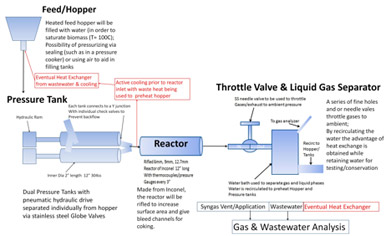People - Students - Cohort 1 - Kenneth Faires
Kenneth Faires
Education: BS, Mechanical Engineering 2002 North Carolina
State University; MS, Mechanical Engineering 2003 Naval Postgraduate
School
Work Experience: More than 4 years of experience as a
naval officer working as an engineer, maintenance manager, and tactical
team leader
Major: Mechanical Engineering
Advisor: Joyce Cooper
Title of Research Project: Super critical
water gasification reliability and scalability
Context of research: My research is aimed ultimately
at helping to alleviate the energy shortage. Biomass is currently a
waste byproduct in many parts of the world. In the US thousands of tons
of yard waste and underbrush are disposed of every year. According to
some studies the energy content/quantity is high enough to entirely
replace gasoline consumption in certain geographical regions. The goal
of my research is to delve into a means of converting biomass into a
more useable fuel, mainly hydrogen. Current methods of biomass to energy
conversion focus primarily on standard gasification and simple combustion.
Both methods require drying, resulting in decreased system efficiency
and increased cost. Additionally, standard gasification tends to not
be overly selective in syngas production. It is my hope that by using
SCW gasification, a fuel that can be utilized directly by fuel cells
will result in improved system efficiency.
Supercritical water gasification is a form of gasification in which the reactor is pressurized and the temperature balanced so that water inside the biomass is at or above its critical point. This process is ideal for wet biomass containing as much as 90% water and yields a carbon build-up to <5% (per kg). Temperatures can range from 650k to 1000k with pressures on the order of 20-35MPa, although typical operating conditions are 700-800k at pressures near 25 MPa.
SCW has a number of advantages that make it preferable over other processes.
The gaseous phase products are “water scrubbed” resulting in a low particulate
high quality gas. The process is also very robust in that a large variety
of biomass can be used. In regards to cost, two of the most financially
draining requirements of other processes, drying and catalysts, are
entirely removed. The graph below illustrates the costs with respect
to hydrogen production of the currently available methods.
Research plan:
- Develop the capacity to perform experimental investigations of fuel and hardware performance for supercritical water gasification.
- Integrate design, performance, reliability, and scalability analyses into Life Cycle Assessments of supercritical water gasification systems
- Contribute to the development of this technology but also to Life Cycle Assessment methodology.
- Construct an actual gasification system and experiment on parameters such as temperature, pressure, feed rate, reactor size, reactor shape, etc.
- Monitor Syngas quality and makeup in order to determine optimal operating parameters for processing of various feedstocks.
Broader impacts of research: Syngas in and of itself
is useful as a fuel for various niche type uses (fuel cells, rocket
engines, etc). If coupled with other process such as the Fischer-Tropsch
or some of the Shell conversion processes, syngas can be converted into
a high-quality gasoline or diesel product that is directly useful to
current transportation systems.





